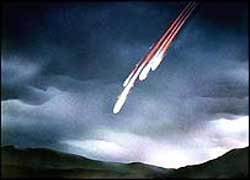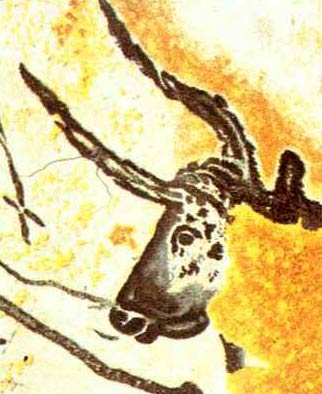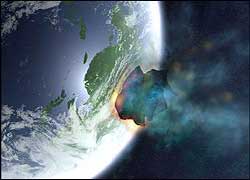|
Books about asteroids,
comets, meteor storms
& ancient catastrophes

“Natural Catastrophes During Bronze Age Civilisations”
(British Archaeological
Reports)
by
Benny J. Peiser
Trevor Palmer
Mark E. Bailey
(Editors)
Get This Book From:
Amazon.com
Amazon.co.uk
Research in the field of neo-catastrophism and impact cratering has quickened its pace since the early 1980s. Scholars such as Victor Clube, Bill Napier, Mark Bailey, Sir Fred Hoyle and Duncan Steel claim that a more ‘active’ sky might have caused major cultural changes of Bronze Age civilizations, belief systems and religious rituals.”
“Rogue Asteroids and
Doomsday Comets
Duncan Steel
(Author)
Arthur C. Clarke
(Foreword)

Get This Book From:
Amazon.com
Amazon.co.uk
“Could both Stonehenge and the pyramids of Egypt have been constructed to observe and commemorate a period of phenomenal meteor storms and asteroid detonations produced by a burst of activity in the Taurid Complex 4,500 to 5,000 years ago? Author Duncan Steel examines the evidence indicating rogue asteroids and doomsday comets may have been behind these and other ancient phenomena.”
“Exodus to Arthur:
Catastrophic
Encounters with
Comets”
Mike Baillie

Get This Book From:
Amazon.com
Amazon.co.uk
“Based on the scientific analysis of tree rings, this text argues that the Earth has undergone several catastrophic encounters with comets and their debris in the last five millennia, with mythology preserving the story better than history. It reveals extraterrestrial bombardment events.
This intriguing challenge to traditional views of history, provides explanations for many of the myths and legends that continue to haunt humankind. In particular, it argues that, in the last five millennia, the Earth has undergone several catastrophic encounters with comets and their debris–and that mythology has preserved these events better than so-called “factual” records.”
“Stonehenge: A New Interpretation of Prehistoric Man
and the Cosmos”
John David North

EU English Edition
“Mysterious Stonehenge has been a magnet for theorists of every stripe for centuries. This new interpretation, by a historian of science (Groningen Univ., the Netherlands), argues that it was both an astronomical observatory and a map of the heavens.
Prof. North argues that Stonehenge’s scientific purpose was to observe the setting midwinter sun, and that astronomical observations made by the ancient Britons were as rational and methodical as they are today.”
“Astronomy Before
the Telescope”
Christopher Walker
(Editor)
Patrick Moore
(Foreword)
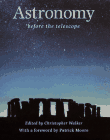
EU English Edition
“From the ancient Egyptians to modern times, mankind has been fascinated by the changing patterns of stars in the night sky. This survey of world astronomy before the invention of the telescope examines how observations were made, and the effects of the new knowledge and its interpetations.
This comprehensive and authoritative study of the world astronomy before 1609 is a superb foundation for anyone interested in our first footsteps into the cosmic realm. 140 photos, 20 in color.”
“Astronomy in Prehistoric Britain
and Ireland”
Clive L. Ruggles
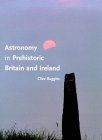
EU English Edition
“For decades debates have boiled among archaeologists and astronomers over the idea that prehistoric stone monuments in Britain deliberately incorporate astronomical alignments. In this book Clive Ruggles is the first to approach the subject from the perspectives of both disciplines. He analyzes the history and lessons of previous debates, the most current research, and new agendas for future research.”
“Canada’s Stonehenge: Astounding Archaeological Discoveries in Canada, England, and Wales”
by
Gordon Freeman
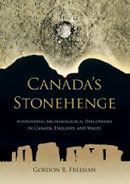
Get This Book From:
Amazon.com
Amazon.co.uk
“The discovery of a 5000-year-old Sun Temple and an ancient “time machine” – Stone Age calendar – in Canada led scientist Gordon Freeman to ground-breaking discoveries in Stonehenge. During fieldwork and research from 1986 to 2006, Freeman found striking similarities between the surface geometry of the two sites.
These similarities push back the boundaries of written history and have far-reaching implications for North American and European history.
Passion and science blend in this remarkable, readable book, as Freeman takes us along on his patient and exciting discovery of a 5000-year-old Temple in the plains of Alberta. What he finds at the Majorville Medicine Wheel in turn informs his convincing account of Stonehenge archaeoastronomy”
“Comets: A Chronological History of Observation, Science, Myth
and Folklore”
by
Donald K. Yeomans 

Get This Book From:
Amazon.com
Amazon.co.uk
|
|
Theories that many ancient megalithic sites began life as some form of observatories acting as ‘early-warning systems’ for imminent impacts of cosmic debris from the break up of a giant comet are only just beginning (October 1997) to get a wider hearing. Such theories, if proven, could help not only to date these monuments, but illustrate how well their builders were oriented in time and space.
The simple appreciation that the Earth orbited the Sun and periodically passes through trails or streams of cosmic debris suggests that some ancient peoples could well have been far more aware of the position of the Earth in the solar system, and the dynamics of the solar system, than has previously been suspected.
Should this prove to be the case, then it would seem that ancient peoples were far more aware of this than are most peoples today.
Dr. Duncan Steel, then of Spaceguard Australia, presented a paper to the Society for Inter-Disciplinary Studies conference at Fitzwilliam College, Cambridge, in July of 1997, in which he gave details of his research suggesting that the earlier ‘henge circle’ which preceded the stone circles at Stonehenge, could have been deliberately constructed to function as a ‘cosmic impact early warning system’.
Stonehenge – Phase I
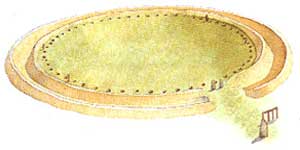
Copyright © 1990, Jean-Pierre Mohen
His paper, “Before the Stones: Stonehenge I as a Cometary Catastrophe Predictor” is must reading for all serious students of archæology and prehistory. The Cambridge conference itself focussed on the effects of natural catastrophes resulting from the impacts of cometary debris as being the main reasons for the sudden destruction of various Bronze Age civilisations.
The Sunday Times of London reported on December 14th. 1997 that new archæological and astronomical evidence indicates that:
“A cataclysmic shower of giant meteors destroyed the great Bronze Age civilisations in Egypt, Mesopotamia and Greece by provoking a series of natural disasters.”
an artists impression of a Bronze Age meteor storm
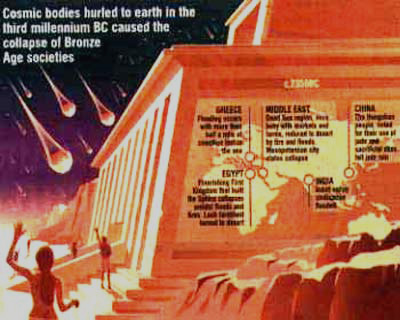
Copyright © 1997, The Sunday Times
The newspaper also gave an outline of the extensive work done by Oxford University astrophysicist, Victor Clube, who has been researching a meteor cluster in orbit around Jupiter, which he says:
” … has collided with the Earth about every 3000 years.”
Both Steel and Clube agree about the cosmic origins of the cataclysms that happened around 2350 BC, and
The Sunday Times article explained that the meteor which exploded over Siberia in June 1908 had:
” … yielded the energy of 2000 Hiroshima nuclear bombs.”
In the 1950’s and 1960’s, Immanuel Velikovsky wrote of cosmic impacts in his books
“Worlds in Collision” and “Earth in Upheaval”. Indeed he is credited with setting many modern skywatchers off on a path that has seen a rapid increase in travellers in the past thirty years or so, and though many of his ideas are treated with derision by the academic community, the seminal influence of his pioneering theories are undeniable – his books began a prehistory debate which is still ‘very hot’, and getting hotter still at the start of the 21st century.
The study of Near Earth Objects (NEOs) is becoming one of the most exciting areas of modern astronomy, and as the science progresses, historical writings and the myths and legends of prehistoric times are being looked at again in a new light. The current focus on re-interpreting ancient myths about battles between ‘sky gods’, ‘dragons breathing fire’, and ‘thunderbolts from heaven’, as containing the accurate observations of ancient skywatchers, is much in the same vein as the pioneering work of Owen Morien Morgan, who decoded the druidic folklore of the South Wales valleys, revealing the druidic oral traditions that symbolically depicted the constant interplay between the Sun, Moon, Earth and planets throughout course of the natural year.
It is becoming evident (October 1997) that ancient peoples have, throughout the past several thousands of years, migrated away from areas devastated by periodic bombardments of cometary debris. These hurried migrations of refugee survivors were likely due not only to the destruction of centres of civilisation, but also as a result of the “Cosmic Winter” caused by the cometary dust-loading of the upper atmosphere which gave rise to abrupt climatic changes – rapid drops in temperature that undermined the agricultural base sustaining those societies. The BSCC that has emerged over the past twenty years is being taken ever more seriously by the military, by various governments, and by other scientists. Quantifying the threat from impacts of NEOs has been given new impetus by the inter-disciplinary studies of historians, archæologists, geologists, climatologists, folklorists and astronomers.
The Rome-based International Spaceguard Foundation is the leading body in the study of planetary defence against impacts of NEOs, but there are other organisations such as the Spaceguard Australia, Spaceguard Canada, as well as NASA, the European Space Agency, and the many universities that also have rapidly growing ‘spacewatch’ projects.
In Britain the leading organisation in this field is Spaceguard UK which is based in Knighton, Wales. They produce a newsletter, “Impact”, containing up to date news about the threat of collisions with Near Earth Objects such as meteors, asteroids and comets, and focusses on efforts to set up an international system of ‘planetary defence’.
a pair of ancient standing stones
Pentre Felw, Ynys Môn, North Wales
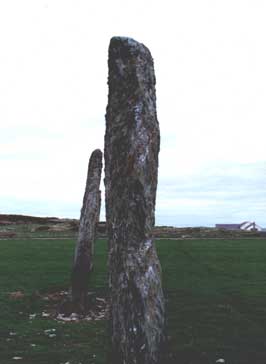
Copyright © March 1997, Morien Institute
Pairs of megalithic standing stones (menhirs), like those above at Pentre Feilw on Holy Island, Ynys Môn, Wales, could theoretically be dated if it were shown that they constituted the ‘foresight’ of an observatory designed to indicate the direction of the ‘radiant’ from which a meteor shower would have appeared to originate as it rose above the horizon. Observed from an appropriate place in that locality, these simple structures could have served as accurate ‘early warning systems’ for ancient peoples who were seeing a much more active sky in terms of meteor showers and storms than we see today.
Only the ‘back-sight’ needs to be located for this, and aerial photographs and fieldwork could identify them – should they exist. If found they could enhance our understanding of the practical usage of these pairs of standing stones in ancient times.
Of course there are many more astronomical events that ancient peoples may well have wanted to observe, but life-critical advance warning of imminent bombardments by cometary debris would be hard to top in any list of priorities by any people in any age.
Some ancient megalithic monuments have been referred to as burial chambers because evidence of burials have been discovered in many of these types of monuments. Some of these burials have not been of humans, but of animals, specifically bulls and less frequently of cows. Others have been shown to have the remains of human skeletons in their chambers, but these burials could well have occurred at a much later date than their construction, and it is now believed that one of their primary purposes may well have been as observatories for particular celestial events.
The burial of bulls may also have been of a relatively late date compared to the dates of the construction of these stone chambers, which would have acted as ‘telescope-type’ chambers inasmuch as they would allow for the fainter stars to be observed at night. And, more importantly, they would have allowed for accurate observation of the ‘heliacal rising’ of specific stars in the final half- hour or so before actual sunrise.
As the major meteor storms of the Bronze Age and before were those that appeared to emanate from the constellation of Taurus (the Bull), then it must be considered that the ‘bull burials’ which have been found in various ancient structures all over the world could well have been the result of an apparent widespread practice of ‘sacrifices’ to appease the anger of various ‘gods’. In ancient oral traditions, this ‘anger’ was almost always shown by the sending of ‘thunderbolts’ and the like, which are recorded in the mythologies and oral traditions of almost every ancient culture in all corners of the globe. Could these sacrifces have been of bulls because of the Taurid Meteors Storms that had caused such widespread death and destruction throughout antiquity? And, how far back did this go?
It must also be remembered that the stars of the constellation of Taurus were observed in much more ancient times as well, and there are many depictions of bulls and ‘bulls heads’ found in caves once used by ancient peoples for both basic shelter from the elements as well as for a wide variety of ‘ritual’ purposes. Did the’elements’ from which ancient peoples sheltered in archaic times also include regular periods of ‘bombardment’ of cometary debris resulting from the break up of a giant comet, encounters with the fragments of which have caused chaos on our fragile planet for countless millennia throughout antiquity?
It is now believed by many scientists that the giant comet was in fact Comet 2P/Encke, which is regarded by most astronomers as the progenitor of the ‘Taurid Meteor Storms’ that must have terrified ancient peoples who were seeing much more active skies in terms of meteor showers and storms than we see today.
Then as now, the rising of the constellation Taurus was preceded by the group of stars known as ‘The Pleiades’, which would have acted as’marker stars’ for the imminent appearance above the horizon of the point, or ‘radiant’, from which the universally-dreaded Taurid meteors would have seemed to originate.
There are two annual episodes of Taurid Meteor Showers still ‘observable’ today, though over the preceeding millennia they have been greatly depleted, and what we see today is a just a pale reflection of some of the ‘meteor storms’ produced by this complex of cometary debris in ancient times.
Our planet encounters the beta Taurid Complex between June 24 and July 6 each year, and it takes the Earth about 12 days to pass through these streams. The second annual encounter is generally between November 3rd and the 15th each year, when they can be seen with the naked eye as ‘shooting-stars’ in the night sky appearing to emanate from the areas of the constellations of Taurus and Aries.
With the stars of the constellation of Taurus in the background behind the Sun in May and June, the meteors appear to come directly out of the Sun. They would not actually be ‘seen until larger meteoroids (particles of cometary debris) came right through the upper atmosphere and impacted the Earth, or burst in the atmosphere a few miles above the ground, as did the widely reported ‘fireball’ of the Tunguska air-burst on June 30th 1908.
This event is believed to have been the result of a large, stoney chunk of cometary debris from the Taurid Complex exploding with the force of 1000 Hiroshima bombs about 5 miles above the Tunguska River valley. How often had this happened in the past? Was there much more debris up there in denser concentrations in the past? Or does our planet simply encounter the denser debris clouds in periods of approx. 3,000 years, as Victor Clube and the ‘coherent catastrophists’ maintain?
Either way, events such as these must have completely terrified the peoples of the Bronze Age and before, but as the periodicity of Comet 2P/Encke is only approx 3.3 years, it would have been such a regular event in the course of any human lifetime that early methods of detecting their intensity are bound to have been developed.
Having pondered on this question for several years, once one stops thinking in terms of modern scientific solutions the simple answer becomes as clear as daylight – controlled daylight that is.
From inside the ancient stone chambers looking out, it would have been possible to see the stars, planets and any other celestial phenomena that passed within the ‘window’ provided by the chambers’ entrances. Indeed, the orientation of the passages, which is different for many of these chambers, may well be in the direction of rising of one or other of the many meteor shower ‘radiants’. This phenomena would have first been noticed by those who took shelter from the bombardments of cometary debris in caves whose entrances coincided with the direction of those rising radiants.
While the main body of the stars of the constellation of Taurus still lay just beneath the local horizon, the meteors, which manifest as ‘shooting-stars, would have streaked up over the horizon during the dawn period following ‘first light’, and would have been visible to anyone whose eyes had ‘dark-adjusted sufficiently after only several minutes inside the cave or chamber entrance.
They would soon have discovered that, as they moved further back into the darkness of the cave or chamber, the ‘window’ would have gotten smaller, the surrounding darkness would have increased, and they would easily have been able to see the ‘flashes’ from the much fainter steaking meteors which would otherwise have been invisible outside the cave or chamber at that time of early morning just after the ‘first light had dawned.
This simple realisation begs the question: Did the peoples of antiquity soon learn how to construct what in effect were ‘artificial caves’ specifically for the purpose of allowing them to see the heliacal risings of ‘warning stars’ and star-groups such as The Pleiades?
Such ‘Artificial caves’ would have served as crude, but efficient, ‘early-warning systems’ for imminent episodes of meteoritic bombardment. And such structures are evident on almost every continent.
Certainly there are many ancient cultures around the world which have paid particular attention to The Pleiades star-group, and while this interest has often been dismissed by prehistorians as part of some ‘primitive’ facination by a wide variety of peoples regarded as ‘pre-literate’, their scientific simplicty and practical usage has gone totally unnoticed by a western European arrogance towards all other cultures that has infected academia for the past 400 years or so.
Driven by greed for gold, the explorers from western Europe, who were encouraged by the desires of an expansionist Catholic Church for total domination over the belief systems they encountered around the world, targetted ancient civilisations far more sophisticated in the sciences of astronomy and natural philosophy than their own during several centuries of ‘carnage’ following the emergence of Europe from the cosmic-impact-induced Dark Ages.
This was the last time that the Taurid Meteor Storms bombarded our planet. And then, in the mid-sixth century AD, just as in earlier times, in many cultures geographically distant from each other on almost every continent, the comets and cometary fragments were depicted as ‘dragons’ breathing fire upon the Earth.
Clive Ruggles’ AR315 course at Leicester University, England, has been one of the focal points for those wishing to study
‘astro-archæology’, or ‘archaeoastronomy’, and the Morien Institute highly recommends a visit to their website.
The reading list for the course is exceptionally good, and includes the compilation book “Astronomy Before the Telescope”, which is one of the best general works on the subject to date. The other essential book for the course, and for anyone wanting to get a better idea of the astronomical observation capablities of ancient peoples, is “Stonehenge: A New Interpretation of Prehistoric Man and the Cosmos” by Prof. John North.
|
|
Ancient Mysteries
Bookshoppe
for a wide selection of
books that challenge
orthodox views of
prehistory on
our planet
“The 2300 BC Event – Vol. 1:
Archaeology and Geophysics
& The Meteoroid Stream”
by
M. M. Mandelkehr
Get This Book From:
Amazon.com
Amazon.co.uk
“The 2300 BC Event takes a new look at an old puzzle: what happened
at this date to cause the various advanced societies on the Earth to simultaneously collapse?
Civilizations in Anatolia and Greece, through Egypt and the Middle East, and eastward to India and Central Asia were at their height. The collapse of these civilizations due to earthquakes and climatic changes has been mirrored by similar interruptions on all continents, in the Arctic, and extending to the Pacific.
The discontinuities have long puzzled archaeologists and historians. New religions and accompanying mythologies appeared at this time in all cultural regions describing bombardment and flooding from the skies.
Strangely, the dominant aspect of the mythologies, however, is the observation and worship of a ring appearing to surround the Earth, oriented to the two Ursa (Bear) constellations.”
“The 2300 BC Event Vol. 2:
Mythology
The Eyewitness Accounts”
by
M. M. Mandelkehr
Get This Book From:
Amazon.com
Amazon.co.uk
“Some time around 2300 BC the Eath encountered a dense clustering of space debris, the early Southern & Northern Taurid meteoroid stream. The result was an intense fall of meteoroids, some of them sufficiently large to cause surface destruction.
Simultaneous with the meteoroid fall was a huge downpouring of water which caused flash flooding. Extensive destruction and loss of life resulted. An astonishing aspect of the event was the formation of a ring surrounding the Earth, reflecting sunlight during the day, hiding some stars at night, and moving around the sky through a 24-hour period.
Following the ‘main event’, there were crustal movements which shifted the location of water sources, and caused earthquakes which destroyed settlements. Abrupt severe climate changes occurred.”
“The 2300 BC Event Vol. 3:
Mythology
The Eyewitness Accounts 2″
by
M. M. Mandelkehr
Get This Book From:
Amazon.com
Amazon.co.uk
“The Northern/Southern Taurid meteoroid stream is identified as the specific meteoroid stream that the Earth encountered at 2300 BC.
The Earth’s encounter with a dense cluster of large objects would produce atmospheric phenomena very different from the pleasant and interesting night displays of meteor trails that are within our own experience.
The rain of objects would have generated extraordinary visual and auditory effects combined with ground vibrations; and under extreme conditions would bring about severe surface destruction and loss of life.
The overall event was associated by the people with powerful deities and formed the basis for major religions. The mythologies and traditions are, in large part, the residues of those religions.”
“Natural Catastrophes During Bronze Age Civilisations”
(British Archaeological
Reports)
by
Benny J. Peiser
Trevor Palmer
Mark E. Bailey
(Editors)
Get This Book From:
Amazon.com
Amazon.co.uk
Research in the field of neo-catastrophism and impact cratering has quickened its pace since the early 1980s. Scholars such as Victor Clube, Bill Napier, Mark Bailey, Sir Fred Hoyle and Duncan Steel claim that a more ‘active’ sky might have caused major cultural changes of Bronze Age civilizations, belief systems and religious rituals.”
“Comets: A Chronological History of Observation, Science, Myth
and Folklore”
by
Donald K. Yeomans 

Get This Book From:
Amazon.com
Amazon.co.uk
Books from our
Astro-Archaeology
Bookshoppe
“A Little History of
Astro-Archaeology:
Stages in the Transformation
of a Heresy”
by
John Michell
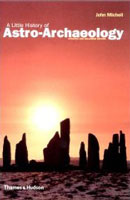
Get This Book From:
Amazon.com
Amazon.co.uk
“Stonehenge today is a battlefield, not only for police and festivalgoers at midsummer but also for rival camps of archaeologists, astronomers, and other researchers into the mysteries of prehistoric religion and science. Controversy flared up in 1963, when Gerald Hawkins made early use of the computer to identify Stonehenge as an observatory for the sun and moon and an instrument for predicting eclipses. Further studies of megalithic sites by Alexander Thom proved that many of them were also related to the seasonal positions of the heavenly bodies.
The study of astro-archaeology has now expanded worldwide, bringing new revelations about the mystical sciences of antiquity. This “little history” summarizes the issues involved in astro-archaeology, and illustrates its principal sites and personalities. Included are recent findings of British scientists, whose records of anomalous levels of natural energies at stone circles are in accordance with the magical reputations of such places in local folklore.”
|


